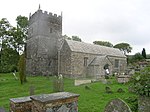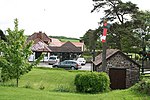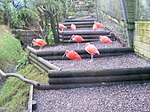River Heddon

The River Heddon is a river in Devon, in the south of England. Running along the western edges of Exmoor, the river reaches the North Devon coast at Heddon's Mouth. The nearest road access to the beach is at Hunter's Inn, approximately 1.6-kilometre (1 mi) south of sea-fall. The named river flows for 8.8 kilometres (5.5 mi) and drains an area of 17.07 square kilometres (6.59 sq mi).The Heddon Valley is renowned for its natural environment, with bridges and stepping stones along the river, meadows, and walks which start from the National Trust shop and information centre which has been in the ownership of the National Trust since 1963. The cobbled beach at Heddon's Mouth is approximately 300 metres (980 ft) wide and is only accessible through footpaths on the National Trust land or via the South West Coast Path. There are remains of a lime kiln on its western edge. The valley immediately landwards of the beach has steep slopes to its east and west, with the hills climbing over 200 metres (660 ft) in altitude within 500 metres (1,600 ft) of the river. The remains of a Roman fortlet are visible on the hilltop to the east of Heddon's Mouth.The Lynton & Barnstaple Railway once ran through part of the valley, halting at the small village of Parracombe.
Excerpt from the Wikipedia article River Heddon (License: CC BY-SA 3.0, Authors, Images).River Heddon
A39, North Devon Parracombe
Geographical coordinates (GPS) Address Nearby Places Show on map
Geographical coordinates (GPS)
| Latitude | Longitude |
|---|---|
| N 51.183333333333 ° | E -3.9 ° |
Address
A39
EX31 4RL North Devon, Parracombe
England, United Kingdom
Open on Google Maps





